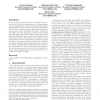Free Online Productivity Tools
i2Speak
i2Symbol
i2OCR
iTex2Img
iWeb2Print
iWeb2Shot
i2Type
iPdf2Split
iPdf2Merge
i2Bopomofo
i2Arabic
i2Style
i2Image
i2PDF
iLatex2Rtf
Sci2ools
CCS
2015
ACM
2015
ACM
Lucky 13 Strikes Back
In this work we show how the Lucky 13 attack can be resurrected in the cloud by gaining access to a virtual machine co-located with the target. Our version of the attack exploits distinguishable cache access times enabled by VM deduplication to detect dummy function calls that only happen in case of an incorrectly CBC-padded TLS packet. Thereby, we gain back a new covert channel not considered in the original paper that enables the Lucky 13 attack. In fact, the new side channel is significantly more accurate, thus yielding a much more effective attack. We briefly survey prominent cryptographic libraries for this vulnerability. The attack currently succeeds to compromise PolarSSL, GnuTLS and CyaSSL on deduplication enabled platforms while the Lucky 13 patches in OpenSSL, Mozilla NSS and MatrixSSL are immune to this vulnerability. We conclude that, any program that follows secret data dependent execution flow is exploitable by side-channel attacks as shown in (but not limited to) ou...
| Added | 17 Apr 2016 |
| Updated | 17 Apr 2016 |
| Type | Journal |
| Year | 2015 |
| Where | CCS |
| Authors | Gorka Irazoqui Apecechea, Mehmet Sinan Inci, Thomas Eisenbarth, Berk Sunar |
Comments (0)

